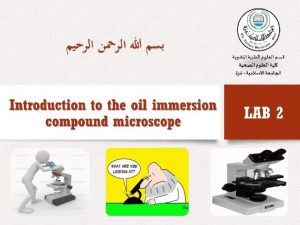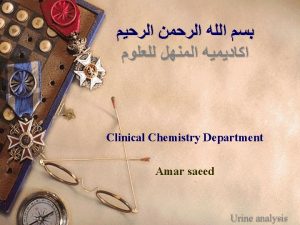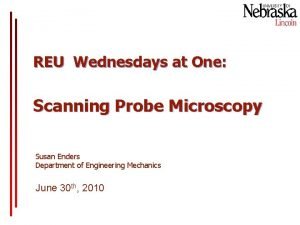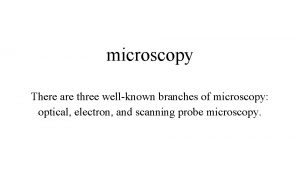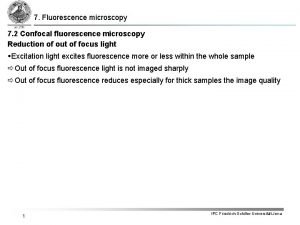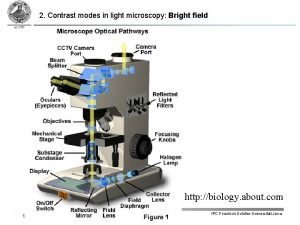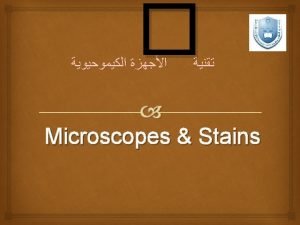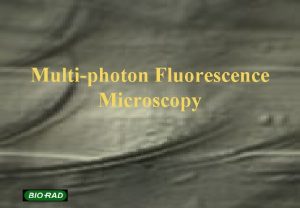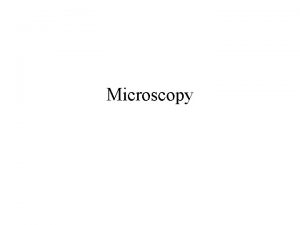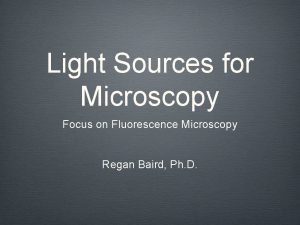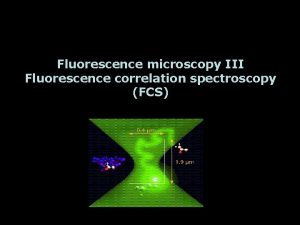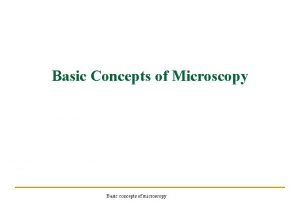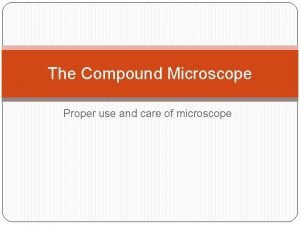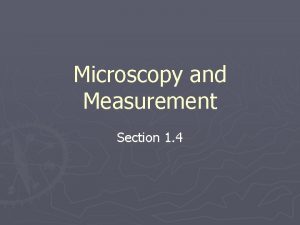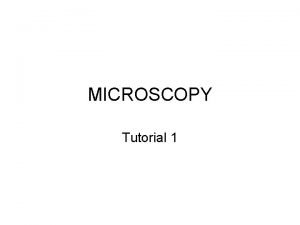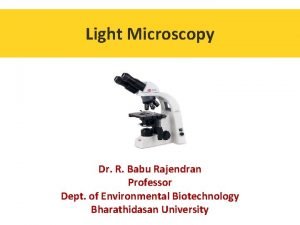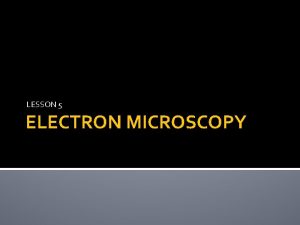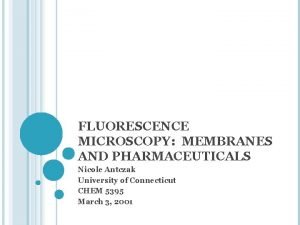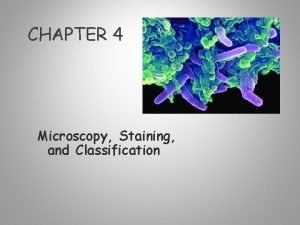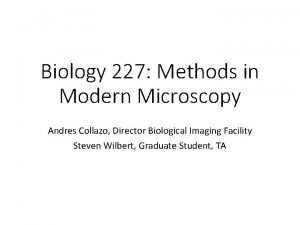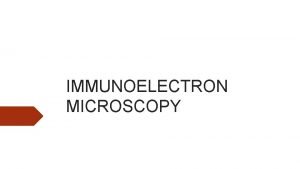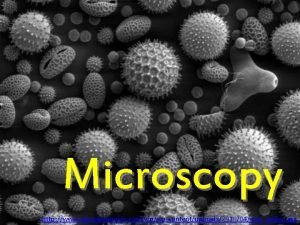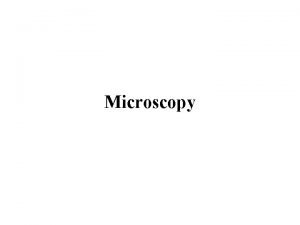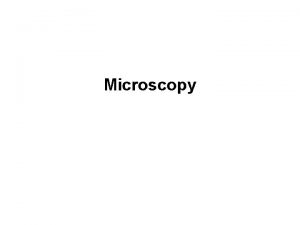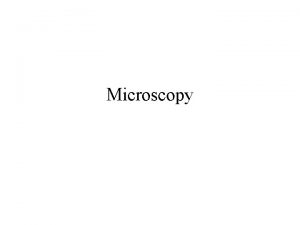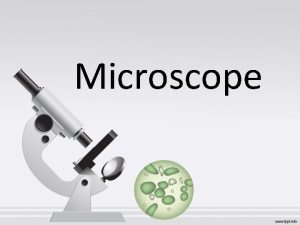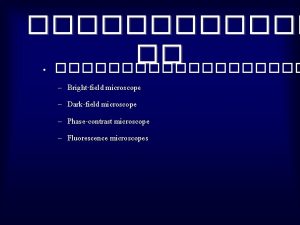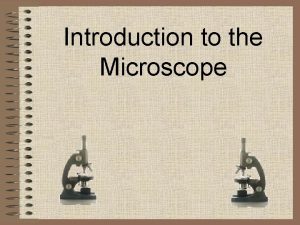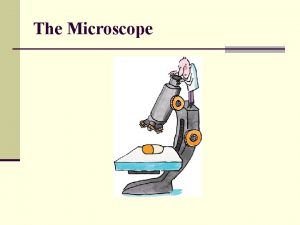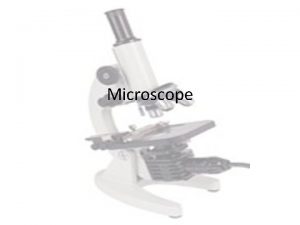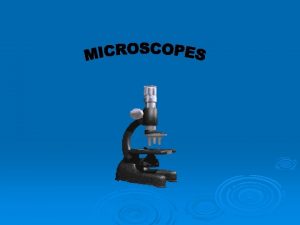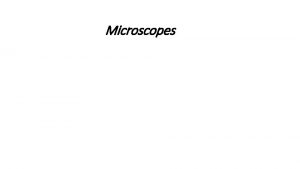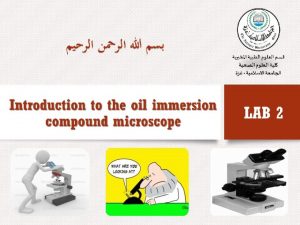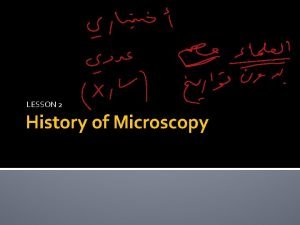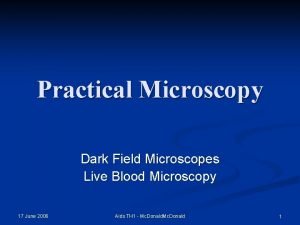Purpose of microscope v Microscopy is the technology








































- Slides: 40


Purpose of microscope v. Microscopy is the technology of making very small things visible to the human eye. v. Used in the diagnosis of many diseases. v. Used for soil, insects and rocks. v. Used in pathological laboratories and medical. v. Industrial microscope : Used for metals and various kinds of measurement. v. Educational microscope: Used for research.

Purpose of microscope in Microbiology v Bacteria is one of the small microorganisms that can’t be seen with the naked eyes, most bacteria range in size between 0. 52. 0 micrometers (μm) so, there is a need to magnify the bacteria several times by using a microscope in order to see it. v Thiomargarita namibiensis is a giant bacteria, 0. 1– 0. 3 mm (100– 300 µm) in diameter, but sometimes attaining 0. 75 mm (750 µm). v There are different types of microscopes which are used in microbial life. v In this lab, you will become familiar with the use of the light compound microscope (particularly oil immersion microscopy) and will compare the relative size and shape of various microorganisms.

Microscope consists of 4 main parts: vframe work. v. Adjustment system. v. Magnification. v. Lighting System.



Frame work Its includes three parts: 1) Base 2) Arm 3) Mechanical stage

Mechanical Stage v Stage- the location of the specimen to be viewed v Clips- utilized in holding the specimen in place

Stage Knobs Control § Top knob: is to move the forward and backward. § Bottom knob: is to move the stage right and left.

Adjustment system It consists of the following parts: 1) 2) 3) Optical tube. Coarse adjustment. Fine adjustment.

Focus and Resolution Parts Coarse-adjustment knob is the larger of the two knobs. It is used in bringing the object into quick focus. v Fine-adjustment knob is used for improving the clarity of the image, especially when viewing under high power. v

Interpupillary adjustment v To control the distance between the ocular lenses to adapt the distance between viewers eyes so, the eyepiece lenses will spread apart or get closer together to fit each individual.

Magnification Microscope has two sets of lenses are : 1) 2) Ocular lens (eyepiece). Objective lens.

Microscope lenses v. Ocular lens or eyepiece is used for viewing. v. Revolving nosepiece contains objective lenses that are used to magnify the image in combination with the ocular lens. v. The objective of microscopy is not just to increase magnification, but to do so while retaining sufficient resolution.

Important points about light microscope 1) Magnification : Relative enlargement of the specimen. 2) Total magnification : § Eyepiece magnification X Objectives magnification. § The image seen by the eye through a compound microscope is termed the virtual image and is upside and reversed.

Important points about light microscope v. Total magnification: Powers of the eyepiece (10 X) multiplied by objective lenses determine total magnification.

Important points about light microscope 3) The numerical aperture (NA): The amount of light reaching the specimen, as NA increase the resolution increase. § NA = angular aperture * refractive index = Sin θ * n § NA depends on the radius of the lens.

Important points about light microscope 4) Resolution: It is the ability of microscope to distinguish two points. v. The smaller the distance between the two specific objects that can be distinguished apart, the greater the resolution power of the microscope. v. The larger NA, the smaller the resolvable distance and hence, the more efficient the resolution power. v r = 0. 612 * λ / NA

5) Depth of focus: thickness of the field; as magnification increased , depth of focus is decreased. 6) Field of vision: the surface area of view; as magnification increased , the area of view decreased.

v. As magnification increased the resolution also increased. v. To achieve high magnification with good resolution the objective lens must have small radius. v. Shorter wavelengths of light provide greater resolution.


v The medium between the objective and the object is a factor that must be taken into consideration for the most effective use of the microscope lens. v The low power objective 4 x, 10 x, and high dry objective 40 x use air. v When oil immersion lenses are employed, a drop of oil should be used, otherwise bending of the light waves occurs since oil has the same RI of glass, while air increase diffraction.

Oil immersion lens

Refraction and Refractive Index v Refraction = bending. v Refractive index: measurement of the extent that the substance bend light. v Field of view > or equal 500 X cause increase in diffraction and this cause distortion of the image.

How to use Microscope 1) Plug in microscope and turn on illuminator. Rotate nosepiece to lock 4 X objective in place 2) Place smear on stage and center it under the 4 X objective. 3) Using the course adjustment knob, move the objective lens to its lowest point. Look through the ocular and focus upward with the coarse adjustment until an image comes into view. 4) Rotate nosepiece to obtain the next objective lens 10 x and repeat step 3.

5) Rotate nosepiece to obtain the next objective lens 40 x. 6) Look through the ocular and focus upward with the fine adjustment until an image comes into view. 7) When using oil immersion lens put a drop of oil on the slide and Rotate nosepiece and repeat step 6.

How to properly carry the microscope Always carry a microscope with one hand holding the arm and one hand under the base.

Factors that influence the quality and size of image v v v Quality of Microscope and lenses. Size of sample. Type of sample. Amount of light on the sample. Quality of sample.

Microscope Maintenance

Microscope Storage v. Proper storage of the microscope will prevent or reduce problems! v. Optics and mechanisms of the microscope must be protected from: § Dust and dirt, § Fungus. v. Store the microscope: § Under a protective cover, § In a low humidity environment.

Cleaning Solutions and Solvents v. Soap solution for cleaning of body and stage. v. Ether-Alcohol, or Lens Cleaner Solution for cleaning of lenses.

Cleaning Materials v. Lens paper § Commercial lens tissue for optics § Caution: Do not use paper towels or other rough paper products. v. Alternatives include: § Fine quality tissue paper § Muslin cloth § Silk

Microscope Cleaning Process v. Cleaning the Eyepiece, v. Cleaning the Objectives, v. Cleaning the Microscope Stage, v. Cleaning the Microscope Body, v. Cleaning the Condenser.

Step 1: Cleaning the Eyepieces v. Blow to remove dust before wiping lens. v. Clean in a circular motion inside out.

Step 2: Cleaning the Eyepiece v. Wipe the eyepieces dry with lens paper. v. Repeat cleaning and drying if required.

Step 3: Cleaning the Objectives v. Objectives should never be removed from the nosepiece.

Step 4: Cleaning the Microscope Stage

Step 5: Cleaning the Microscope Body v. Unplug the microscope from power source. v. Wipe the microscope body to remove dust, dirt, and oil.

Step 6: Cleaning the Condenser v. Unplug the microscope from power source. v. Clean the condenser lens and auxiliary lens using lint-free cotton swabs moistened with lens cleaning solution. v. Wipe with dry swabs.

 Difference between light microscope and electron microscope
Difference between light microscope and electron microscope Microscope mania compound light microscope
Microscope mania compound light microscope Purpose of a microscope
Purpose of a microscope Disadvantage of phase contrast microscope
Disadvantage of phase contrast microscope Selective media for vibrio cholera
Selective media for vibrio cholera Urine microscopy
Urine microscopy Advantages of scanning probe microscopy
Advantages of scanning probe microscopy Provider performed microscopy
Provider performed microscopy Fazekas scale
Fazekas scale Branches of microscopy
Branches of microscopy Pyuria leukocytes urine
Pyuria leukocytes urine What is forensic microscopy
What is forensic microscopy Evan seltzer
Evan seltzer Alzheimer's disease microscopy
Alzheimer's disease microscopy Confocal fluorescence microscopy
Confocal fluorescence microscopy Dark field vs phase contrast
Dark field vs phase contrast Fluorescence microscopy uses
Fluorescence microscopy uses 1674 microscopy
1674 microscopy Photo emission microscopy failure analysis
Photo emission microscopy failure analysis Multiphoton microscopy principle
Multiphoton microscopy principle Compound microscope use
Compound microscope use Light sources for fluorescence microscopy
Light sources for fluorescence microscopy Hyperemia and congestion difference
Hyperemia and congestion difference Fcs microscopy
Fcs microscopy Basic concepts of microscopy
Basic concepts of microscopy Electron microscopy data bank
Electron microscopy data bank Uses of light microscopes
Uses of light microscopes Microscopy and measurement section 1-4 review
Microscopy and measurement section 1-4 review Dark ground microscopy
Dark ground microscopy Scanning thermal microscopy
Scanning thermal microscopy Types of microscopy
Types of microscopy Dark field microscopy
Dark field microscopy Types of microscopy
Types of microscopy Laser confocal microscopy
Laser confocal microscopy Light sheet microscopy
Light sheet microscopy Laser confocal microscopy
Laser confocal microscopy Electron microscopy
Electron microscopy Phage typing
Phage typing Microscopy
Microscopy Fluorescence microscopy
Fluorescence microscopy Giemsa stain
Giemsa stain


